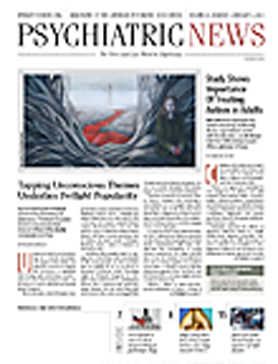Conventional therapeutic approaches that rely on face-to-face contacts with individual patients may not be sufficient to handle the expected influx of posttraumatic stress cases as thousands of U.S. troops return from combat zones, Terrance Keane, Ph.D., told attendees at the Fourth Annual Trauma Spectrum Conference at the National Institutes of Health in Bethesda, Md., last month.
When Keane first began studying and treating posttraumatic stress disorder (PTSD) in the late 1970s, the diagnosis had not yet been named, and the check-off scale used to measure combat exposure in Vietnam War veterans topped out at 50 engagements.
Combat exposure varies, but the worst-hit units in Afghanistan might engage in hundreds of firefights over several deployments, said Keane, director of the National Center for PTSD’s Behavioral Sciences Division, associate chief of staff for research and development at the VA Boston Healthcare System, and a professor of psychiatry at Boston University School of Medicine.
The worst things they bring back with them are the loss of their friends and a sense of guilt for not being killed, he said.
PTSD is an anxiety disorder involving the fear circuitry and learning systems, and exposure therapy has the strongest experimental evidence of efficacy for treating PTSD, according to the Institute of Medicine.
“Exposure therapy helps people face their fears and process them in the context of an interpersonal relationship,” said Keane.
However, successful therapy implies a willingness to disclose, and that can be difficult. A mere recital of the facts is not enough.
“The therapist has to elicit great detail about the patient’s visions, images, and feelings—often of rage and shame— associated with the traumatic event,” said Keane. “Disclosure is a complicated matter.”
Research has produced several evidence-based variants of exposure therapy, all of which include disclosure of the event, therapeutic exposure to it, cognitive restructuring of the experience, education about trauma and PTSD, and learning skills for managing anxiety. The therapist may not use all of these techniques at the same time, but they serve as a toolkit to be drawn from as needed.
The VA and the Department of Defense have heavily recruited social workers, counselors, psychologists, and psychiatrists in recent years, but have had to provide additional training in exposure therapy before these clinicians can work with patients, he said.
Better Training Needed
Even increased numbers of trained therapists can’t reach all the troops (not to mention civilians) who need help. The problem is that all those professions are insufficiently trained in current evidence-based exposure therapy techniques because few faculty members have those skills, said Keane.
However, technology may allow wider access to care for patients and more opportunities for researchers.
For example the DESTRESS trial, reported in 2007, found a reduction in PTSD symptoms compared with controls among users of a therapist-assisted program over the Internet.
At the conference, Keane reported on the status of an ongoing study of comorbid alcohol abuse and PTSD, cosponsored by the National Institute on Alcohol Abuse and Alcoholism and the National Center for PTSD.
The combination is a common presentation for veterans of the recent wars, but, said Keane, “treatment begins with whatever door the soldier walks through first” at the VA—either a substance abuse program or an anxiety disorders program.
Web-Based Program Developed
Seeking a method that would combine rather than separate the two problems, Keane and colleagues developed an anonymous, Web-based program of assessment and treatment and tested it on nearly 600 subjects so far. The intervention cut the number of drinks consumed per week from 29 to 15 and the number of heavy drinking days in the prior month from 35 percent to 15 percent, he said. (The results have not yet been published.)
In the process, Keane and colleagues also found a way to use Facebook to recruit younger veterans while screening out ineligible applicants, all at a low cost ($30) per randomized participant for promotion and staff time. With added security precautions, Web applications might well broaden access to treatment while developing cheaper ways to track outcomes, he said.
The Web site for Terry Keane’s VetChange self-management program for PTSD and drinking problems is www.vetchange.org/home. 
